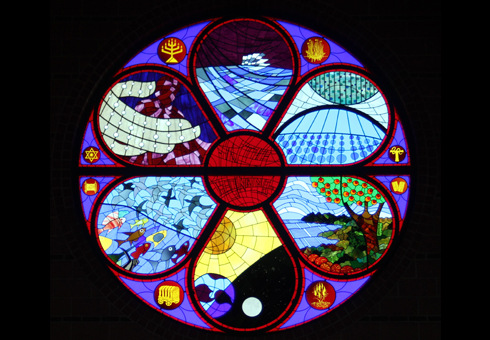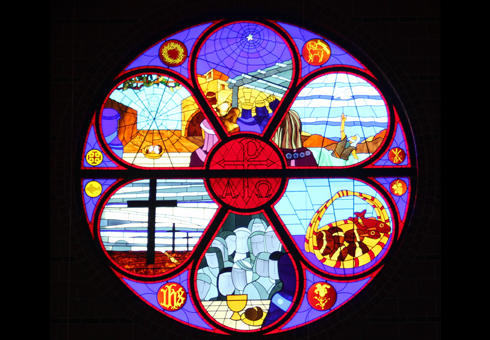Working clockwise from the top, various symbols in the Creation Window represent key reminders from the Old Testament of God’s presence, then and now:
- The basket in the reeds – recalls the rescue story of infant Moses (Exodus 2:1-10) and is a sign of divine providence at work.
- The serpent on the pole – represents Moses’ intercession after many Israelites were bitten by snakes as a consequence of their impatience with God (Numbers 21:4-9); it has become a sign of God’s grace even in the midst of God’s displeasure.
- The stone tablets – symbolizes the Ten Commandments (Exodus 20:1-17) which constitutes the fundamental moral law for both Jews and Christians.
- The burning bush – signifies the call of Moses to deliver the Israelites from the bondage of the Egyptians (Exodus 3:1-4); it also serves as a reminder that God still calls people today in the midst of everyday living.
- The ark of the covenant – symbolizes both Hebrew worship and the presence of God (Numbers 10:35-36); inside were the stone tablets, Aaron’s rod, and a jar of manna, all reminders of the grace and providence of God through the wilderness experience.
- The scroll – denotes the book of the Hebrew people upon which was written the words of the Torah (the five books of Moses) as well as the writings of the prophets and historians of Israel; it symbolizes the written testimony of God’s word to the covenant community.
- The Star of David – characterizes the covenant which God made with King David (II Samuel 7:8-13) that an heir of his would come to reign forever; Jesus, from David’s lineage, established that eternal kingdom (Luke 1:31-33)!
- The menorah – represents the seven-branched candlestick used to illumine the interior of the holy place (Exodus 25:31-40); the significance of the seven lights is variously interpreted to represent the seven days of creation or the seven gifts of the Holy Spirit, seven being the number of perfection and completeness.




